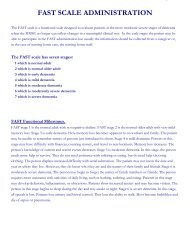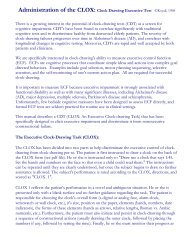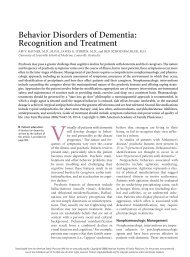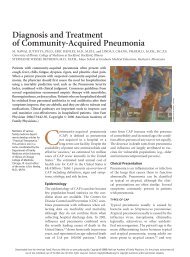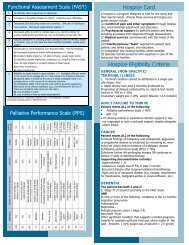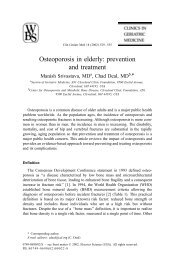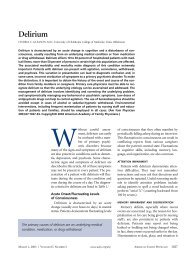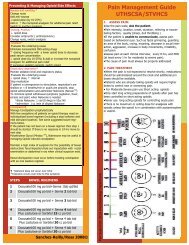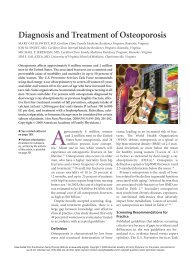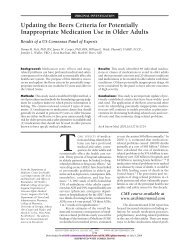the mini-cog - John A. Hartford Center of Excellence in Geriatrics ...
the mini-cog - John A. Hartford Center of Excellence in Geriatrics ...
the mini-cog - John A. Hartford Center of Excellence in Geriatrics ...
Create successful ePaper yourself
Turn your PDF publications into a flip-book with our unique Google optimized e-Paper software.
Table 2. Alternative M<strong>in</strong>i-Cog algorithms<br />
MMSE and CASI corresponded relatively well<br />
with <strong>the</strong>ir po<strong>in</strong>ts <strong>of</strong> optimal function (<strong>the</strong> best<br />
balance <strong>of</strong> sensitivity and speci®city) <strong>in</strong> this sample.<br />
When <strong>the</strong> performance <strong>of</strong> algorithm 7 (Table 3,<br />
henceforth referred to as <strong>the</strong> M<strong>in</strong>i-Cog) was<br />
compared with <strong>the</strong> o<strong>the</strong>r dementia screens (threeitem<br />
alone, CDT alone, CASI, and MMSE), it<br />
performed best <strong>in</strong> sensitivity (99%) and diagnostic<br />
value (96%) and had acceptable speci®city (93%),<br />
though it was less e cient <strong>in</strong> classify<strong>in</strong>g nondemented<br />
subjects than <strong>the</strong> CASI (96%). The<br />
MMSE was <strong>the</strong> least sensitive (91%) and speci®c<br />
(92%) (Borson et al., 2000). When separate logistic<br />
regression analyses predict<strong>in</strong>g correct diagnosis<br />
and controll<strong>in</strong>g for <strong>the</strong> e€ects <strong>of</strong> education and<br />
non-native language (English/non-English) were<br />
performed <strong>the</strong> results were strik<strong>in</strong>g. The M<strong>in</strong>i-Cog<br />
was most predictive (w 2 ˆ273), followed by <strong>the</strong><br />
CASI (w 2 ˆ233) and <strong>the</strong> MMSE (w 2 ˆ201; see<br />
Borson et al., 2000, for detailed description).<br />
CDT classi®cation by naõÈve subjects<br />
CDT judgments by naõÈ ve raters (normal or<br />
abnormal) were compared with expert judgments<br />
us<strong>in</strong>g CERAD categories (0, 1, 2, 3). Concordance<br />
between naõÈ ve and expert raters was extremely high<br />
for CERAD categories 0, 2 and 3 (498%) and<br />
Table 3. NaõÈ ve vs expert CDT rat<strong>in</strong>gs<br />
NaõÈ ve raters Expert raters CERAD categories<br />
0 1 2 3<br />
Normal 392 (98){ 160 (40) 8 (2) 1 (0.2)<br />
Abnormal 8 (2) 240 (60) 392 (98) 399 (99.8)<br />
Absolute frequency based on Nˆ400 (20 naõÈ ve raters 20<br />
CDTs with<strong>in</strong> each CDT category).<br />
{Percentages.<br />
THE MINI-COG 219<br />
Algorithm Judged non-demented Judged demented<br />
1 Recallˆ3 and CDTˆ0 Recallˆ0±2 or CDTˆ1±3<br />
2 Recallˆ2±3 and CDTˆ0 Recallˆ0±1 or CDTˆ1±3<br />
3 Recallˆ1±3 and CDTˆ0 Recallˆ0 or CDTˆ1±3<br />
4 Recallˆ1±3 or CDTˆ0±2 Recallˆ0 and CDTˆ3<br />
5 Recallˆ1±3 or CDTˆ0±1 Recallˆ0±1 and CDTˆ2±3<br />
6 Recallˆ1±3 or CDTˆ0 Recallˆ0 and CDTˆ1±3<br />
7 M<strong>in</strong>i-Cog Recallˆ3 or (Recallˆ1±2 and CDTˆ0) Recallˆ0 or (Recallˆ1±2 and CDTˆ1±3)<br />
weaker for category 1 (60%) (Table 3). The 40% <strong>of</strong><br />
naõÈ ve rat<strong>in</strong>gs discordant for mildly impaired CDTs,<br />
as judged by research raters, were uniformly rated<br />
as normal. Overall concordance between naõÈ ve and<br />
expert raters was 89%.<br />
We evaluated <strong>the</strong> projected M<strong>in</strong>i-Cog performance<br />
as if it had been ad<strong>m<strong>in</strong>i</strong>stered by naõÈ ve raters<br />
to our entire subject sample. We made <strong>the</strong><br />
follow<strong>in</strong>g assumptions: that <strong>the</strong> naõÈ ve raters<br />
properly ad<strong>m<strong>in</strong>i</strong>stered <strong>the</strong> three-item recall task,<br />
that subjects received appropriate CDT <strong>in</strong>structions,<br />
that all mildly impaired CDTs were scored<br />
normal (ra<strong>the</strong>r than <strong>the</strong> 40% found here), and all<br />
o<strong>the</strong>r CDTs were scored identically to research<br />
rat<strong>in</strong>gs (ra<strong>the</strong>r than <strong>the</strong> 98±99% found here).<br />
Under <strong>the</strong>se circumstances, M<strong>in</strong>i-Cog sensitivity<br />
would decrease from 99 to 97%, and speci®city<br />
would <strong>in</strong>crease from 93 to 95%, both well with<strong>in</strong><br />
e€ective screen<strong>in</strong>g ranges. The percentage <strong>of</strong><br />
subjects with mildly impaired CDTs <strong>in</strong> this sample<br />
was small (10%), and 67% <strong>of</strong> <strong>the</strong>se recalled 0/3<br />
words.<br />
DISCUSSION<br />
We have previously reported that <strong>the</strong> comb<strong>in</strong>ation<br />
<strong>of</strong> <strong>the</strong> three-item recall task with <strong>the</strong> CDT results <strong>in</strong><br />
superior dementia prediction relative to ei<strong>the</strong>r <strong>of</strong> its<br />
parts and to <strong>the</strong> CASI and MMSE <strong>in</strong> a very<br />
heterogeneous community sample (Borson et al.,<br />
1999). Inspection <strong>of</strong> <strong>the</strong> ROC curves shown here<br />
fur<strong>the</strong>r explicates those ®nd<strong>in</strong>gs. First, <strong>the</strong> conventional<br />
cut-o€ po<strong>in</strong>ts for <strong>the</strong> MMSE (23/24) and<br />
CASI (80/81) worked as expected <strong>in</strong> heterogeneous<br />
samples <strong>of</strong> older adults, produc<strong>in</strong>g <strong>the</strong> best<br />
sensitivity/speci®city comb<strong>in</strong>ation atta<strong>in</strong>able with<br />
<strong>the</strong>se <strong>in</strong>struments <strong>in</strong> this sample. Exa<strong>m<strong>in</strong>i</strong>ng our<br />
algorithms (Table 2 and Fig. 1) we see that<br />
numbers 1±3 tend to maximize sensitivity, while<br />
4±6 maximize speci®city and 7 (<strong>the</strong> M<strong>in</strong>i-Cog) is a<br />
Copyright # 2001 <strong>John</strong> Wiley & Sons, Ltd. Int. J. Geriatr. Psychiatry 16, 216±222 (2001)



